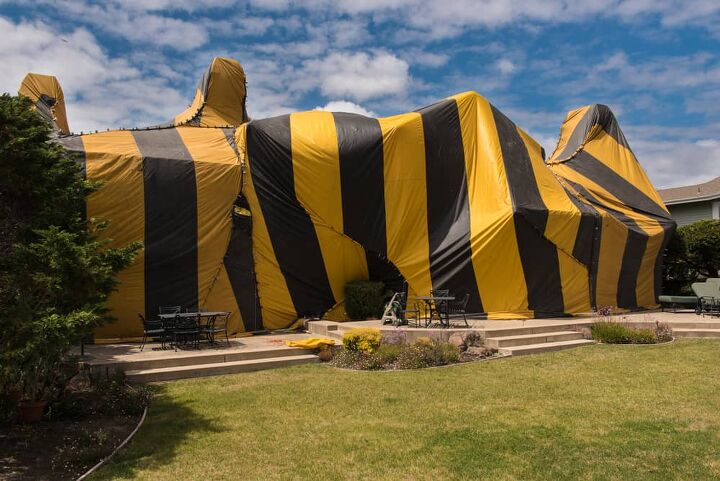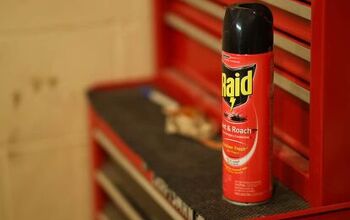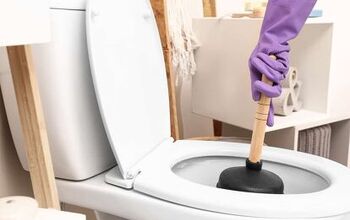How Long After Fumigation Is It Safe To Return Home? (Find Out Now!)

When we have pest problems in our houses, sometimes fumigation becomes necessary. Are you thinking about fumigating your house? Are you wondering how much time you will have to wait before re-entering the property?
You are able to return to your home 72 hours after fumigation. This is due to the levels of toxic gases that still sit in your home after fumigation occurs. Once you get home, open windows and turn on fans to help ensure that all toxic gases are out of the area.
If you’re going to fumigate your house, get specific safety information from the professionals doing the job.
When Can You Return Home After Fumigation?
Most people want to return home 24 hours after fumigation. While this may be feasible in some cases, it’s best to wait until 72 hours so that you can ensure all of the toxic fumes are out of the home so you don’t risk poisoning.
What Do You Do After Fumigation?
Make sure you follow professional instructions about how long to wait before re-entering your house. Once it is safe to re-enter your house, thoroughly clean the house.
It’s crucial to follow your exterminator’s specific instructions after the fumigation. There are certain kinds of fumigation treatments where you will need to stay away from specific kinds of cleaning afterward for several days.
An example of this is sometimes fumigation for roaches. But again, ask your professional extermination company for specific instructions.
Check Edibles
Look for any edibles that are still open and that may have been exposed to the fumigants. You will need to throw these away. These might include crackers, potato chips, sugar, and butter.
Vacuum Your House
After this, thoroughly vacuum your house. You will probably find dead bugs, and you will need to vacuum these up.
Throw away the vacuum bag after this. Move over all rugs and furniture to make the vacuuming more detailed. Get under and into all areas.
Clean Surfaces
Use a damp cloth to clean off all surfaces in your house. You should throw away this cloth after you are done.
Once that is done, use a vinegar and water solution to clean everything again. Don’t forget to clean off door handles, doors, and medicine cabinets.
Clean Up The Rest
Clean all hard floor surfaces, such as the bathroom floor. You should also wipe down your washer and dryer.
Vacuum your mattress and wash your pillows. You could even consider buying new pillows. If your fumigation is for bed bugs, carefully follow all the instructions given to you by professionals.
How Can I Stay Safe After Fumigation?
Knowing a few key facts regarding fumigation will help you and your pets have the most enjoyable experience possible.
The first is that fumigation, aside from commercially accessible products, should only be performed by licensed specialists. Fumigation, if done incorrectly, can be extremely dangerous not just to you, your pets, and your home, but also to your neighbors.
The second component of fumigation safety to consider is what occurs before any treatment is administered. Remove, seal, open, and turn off are the four categories for these tasks.
Remove Items
Before you fumigate, remove the following items from your home, although not necessarily all of them:
- Ice (in an icemaker)
- Food (including cat food) can be opened.
- People, pets, and plants (hanging and potted)
- Automobiles (if in an attached garage)
- Wetsuits
- Crates or cages for pets (if possible)
Seal Up Belongings
This stage primarily covers objects that you could remove but don’t have to if you carefully seal them in Nylofume bags, such as:
- Dental supplies
- Meals(including candy, gum, human and pet food in your pantry, and anything in your fridge and freezer)
- Chew toys for pets
- Medications
Open Up Items
After removing and sealing so many items, it may seem strange to open others, but it makes sense. To begin, any plastic bags or wraps that hold or cover goods such as furniture, mattresses, or clothing. This will allow the fumigant to aerate more effectively, allowing the toxins to leave your home faster.
You should also open the following:
- Cupboards
- Closets
- Pet crates
- Cabinets
- Drawers
- Lockers
- Vaults
- Safes
The goal is to allow the fumigant to flow freely so that it can cover the entire region and aerate more quickly.
Turn Off Items
Before you begin fumigating, ensure sure your air conditioner is turned off and that you have contacted the gas company to have the supply to your home turned off throughout the procedure. This is due to the fact that some of the compounds are extremely combustible.
What Are The Different Types Of Fumigation?
There are different kinds of fumigation. Every type of fumigation uses chemicals called fumigants to get rid of insects and pests in your home.
Fumigation is always a hazardous process. This is why you have to leave the space empty for a certain amount of time before re-entering the property. Ask the professional service that fumigates your house what the length of time is.
Gas Fumigation
Gas fumigation uses fumigants that are in the gaseous state to get rid of pests. When gas fumigation is done, it is done inside a closed chamber.
Professionals doing the fumigation will use a gas-proof covering to enclose the space. This method of fumigation is also referred to as space fumigation. It makes sure that none of the toxic fumigants will get into the external environment.
A common gaseous fumigant used for the control of insects, termites, rodents, weeds, and nematodes is methyl bromide. The entire area must be entirely cleared of all people and animals before gas fumigation can take place.
Solid Fumigants
Solid fumigation uses solid fumigants for getting rid of insects. This process is done by sprinkling powders, pellets, or tablets (in measured quantities) into specific areas.
It’s easier for professionals to sue solid fumigants instead of gaseous fumigants, and they aren’t as damaging to the environment. However, you should be aware that there are still potential health impacts from solid fumigation.
A common solid fumigant is aluminum phosphide. It is used to get rid of insects and pests in every stage of development (for example, insect larvae, eggs, pupae, and adults). Another solid fumigant is calcium cyanide. Solid fumigants are often used as part of fumigation plans for cockroaches.
Liquid Fumigants
When liquid chemicals are used for fumigation, it gets rid of insects, pests, and/or mold. Professionals put liquid fumigants in sprayers and then sprayed in large quantities. Most kinds of liquid fumigants are poisonous to humans. They are also volatile and flammable.
Many experts say that fumigation with liquid fumigants works more quickly than when you use solid fumigants. When professionals do liquid fumigation, it is most safely done when performed in an enclosed fumigation chamber or outdoors.
What Happens If You Go In Too Soon After Fumigation?
It is dangerous to go back inside too soon after fumigation. If you do go in too soon, you are likely to experience certain symptoms. These symptoms are signs of danger. Some of these symptoms include:
- Headaches
- Fatigue
- Difficulties with breathing
- Nausea
- Dizziness
- Fatigue
- Dizziness
- Double vision
Pet Symptoms
- Tremors
- Bleeding
- Seizures
- Convulsions
- Passing out
- Problems with breathing
If you or your pet has any symptoms like this, you must get medical attention right away. If it’s your pet, contact your veterinarian immediately.
How Long After Fumigation Is It Safe For Pets?
Remember that fumigation is just as dangerous for pets as it is for humans. Consult with the professionals doing the treatment to find out how long you need to wait.
How long you will need to wait for your pets to go into the house will depend on many different factors. This includes the kind of treatment that was used, as well as the dosage, how it was used, and so on.
What Kinds Of Infestations Need Fumigation?
Whether an infestation should be dealt with using fumigation depends on a variety of factors. Some examples of situations in which fumigation might be the right choice include:
- If the pests are in places that aren’t easily accessible: It’s extremely difficult to get rid of pests that are within inaccessible places if you don’t fumigate. Examples of such pests might be termites and specific kinds of beetles. Extremely persistent pests, such as cockroaches, often require fumigation of some kind.
- If the infestation is compromising your sources of food: Examples of this are often in industrial and commercial places, such as restaurants.
- If you only need a one-time elimination of the pest: If it seems like you will only need to fumigate once in order to get rid of a pest, fumigation often makes sense. Ask professional pest control companies how long you can expect the fumigation’s effects to last.
Cockroach Fumigation
With many cockroach fumigation techniques, the professionals will use baiting and spraying. Make sure to ask the professionals how long you should wait not only to go into the house, but to clean.
If you clean too soon, it can interfere with the treatment’s efficacy. Remember, cockroaches are notoriously hard to get rid of. You need to do everything correctly.
Many professionals will tell you to wait between five and ten days before doing any kind of thorough cleaning. If you have pets, specifically ask them how long you should wait before your pets are allowed back in. You may have to wait longer to bring your pets home than you have to wait to go inside yourself.
Bed Bug Extermination
There are several different approaches to bed bug extermination. If the infestation is very bad and you think the bed bugs might also be in other areas of the house, you might consider fumigation. Fumigation (as well as thermal extermination) services for bed bugs are very expensive.
Take all clothing, food, and water out of the area that will be treated. Fumigation is dangerous for both people and animals, so make sure neither is in the house when fumigation is done.
Ask your extermination professionals for guidance on how long you should wait before going into the property and all other instructions, too.
How Long Does Fumigation Treatment Last?
How long the pest-control effects of fumigation last depends on what kind of fumigation it is. It also depends on what kind of pests are involved. Generally speaking, pest control treatment will last a bare minimum of a few months. However, you cannot assume you will always be free of the pest just because you did fumigation.
Check with your pest control company about whether they offer any guarantees. Many companies recommend that they come in on a periodic basis to do inspections. If necessary, new treatments will be needed at that time.
Related Questions
What are Common Household Pests?
There are many different kinds of pests that you may have to deal with in your home. To figure out how to deal with the issue, you must know which pests (or pests) are present. Some common pests include cockroaches, mice and rats, ants, flies, and bedbugs.It is best to try to prevent an infestation from developing in the first place. Try to avoid having too much clutter or food sitting around in your home. Insects are attracted to these things. Keep your home as clean and tidy as possible.

We are a team of passionate homeowners, home improvement pros, and DIY enthusiasts who enjoy sharing home improvement, housekeeping, decorating, and more with other homeowners! Whether you're looking for a step-by-step guide on fixing an appliance or the cost of installing a fence, we've here to help.
More by Upgraded Home Team























![Cost To Drill A Well [Pricing Per Foot & Cost By State]](https://cdn-fastly.upgradedhome.com/media/2023/07/31/9074980/cost-to-drill-a-well-pricing-per-foot-cost-by-state.jpg?size=350x220)
![Standard Dining Room Table Dimensions [for 4, 6, 8, 10 and 12 People]](https://cdn-fastly.upgradedhome.com/media/2023/07/31/9074335/standard-dining-room-table-dimensions-for-4-6-8-10-and-12-people.jpg?size=350x220)


